Homeobox protein B6 and homeobox protein B8 control immune-cancer cell interactions in pancreatic cancer
- PMID: 40619489
- PMCID: PMC12229978
- DOI: 10.1186/s43556-025-00292-5
Homeobox protein B6 and homeobox protein B8 control immune-cancer cell interactions in pancreatic cancer
Abstract
Pancreatic ductal adenocarcinoma (PDAC) is a lethal cancer lacking effective drugs and therefore new treatment targets are needed. In this study, we define the role of homeobox protein B6 (HOXB6) and HOXB8 in controlling pancreatic cancer tumorigenesis and immune response. Transcriptomic analysis comparing human embryonic and PDAC tissue identified a large overlap of expression profiles suggesting a re-initiation of developmental programs in pancreatic cancer. Specifically, we identified the transcription factors HOXB6 and HOXB8 as potential regulators in PDAC. We described their functions in pancreatic cancer by performing transcriptomic and tumor tissue microarray analyses, in vitro assays in pancreatic and lung cancer cell lines and co-culture experiments with immune cells. Loss of HOXB6 and HOXB8 in pancreatic cancer cells inhibited cell proliferation, induced apoptosis and senescence and enhanced gemcitabine sensitivity. Moreover, reduced HOXB6 and HOXB8 expression in pancreatic and lung adenocarcinoma cell lines affected transcription of immune response pathways which resulted in an increased sensitivity of cancer cells to anti-tumorigenic activities of macrophages suggesting that the HOXB6 and HOXB8 immune regulatory function is conserved in different cancer types. Additionally, naïve M0 macrophages exposed to HOXB8 deficient PDAC cells were unable to differentiate into tumor-associated macrophages, suggesting that HOXB8 promotes the transition of initial anti-tumor macrophage to a tumor-promoting macrophage phenotype in pancreatic cancer. Our findings indicate that HOXB6 and HOXB8 play important roles in regulating cell proliferation, immune response, and treatment resistance to promote pancreatic cancer tumorigenesis and could be useful therapeutic targets.
Keywords: Fetal pancreas; Homeobox protein B6 (HOXB6); Homeobox protein B8 (HOXB8); Pancreatic cancer; Pancreatic ductal adenocarcinoma; Tumor-associated-macrophages.
© 2025. The Author(s).
Conflict of interest statement
Declarations. Ethics approval and consent to participate: Ethical permission has been obtained from the regional ethics committee in Lund (Dnr2012/593, Dnr 2015/241, Dnr 2018–579). The Surgical Ethics Committee of HUH approved the study protocol (Dnr. HUH 226/E6/06, extension TKM02 §66 17.4.2013). Informed consent was obtained from all subjects involved in the study. Consent for publication: Not applicable. Competing interests: All author declared no conflict of interest.
Figures

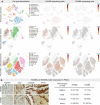
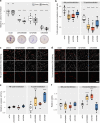
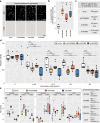
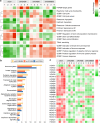

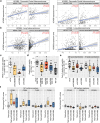
Similar articles
-
G3BP2 promotes tumor progression and gemcitabine resistance in PDAC via regulating PDIA3-DKC1-hENT in a stress granules-dependent manner.Acta Pharmacol Sin. 2025 Feb;46(2):474-488. doi: 10.1038/s41401-024-01387-5. Epub 2024 Sep 17. Acta Pharmacol Sin. 2025. PMID: 39289547
-
Phosphorylation of USP32 by CDK5 regulates Rap1 stability and therapeutic resistance in pancreatic ductal adenocarcinoma.Oncogene. 2025 Aug;44(30):2634-2645. doi: 10.1038/s41388-024-03263-2. Epub 2025 May 16. Oncogene. 2025. PMID: 40379759
-
TYROBP overexpression alters macrophage phenotype and enhances pancreatic cancer stemness through STAT3 and PKM2 signaling.Cell Signal. 2025 Oct;134:111949. doi: 10.1016/j.cellsig.2025.111949. Epub 2025 Jun 18. Cell Signal. 2025. PMID: 40553966
-
Roles of lncRNAs in pancreatic ductal adenocarcinoma: Diagnosis, treatment, and the development of drug resistance.Hepatobiliary Pancreat Dis Int. 2023 Apr;22(2):128-139. doi: 10.1016/j.hbpd.2022.12.002. Epub 2022 Dec 14. Hepatobiliary Pancreat Dis Int. 2023. PMID: 36543619
-
A rapid and systematic review of the clinical effectiveness and cost-effectiveness of paclitaxel, docetaxel, gemcitabine and vinorelbine in non-small-cell lung cancer.Health Technol Assess. 2001;5(32):1-195. doi: 10.3310/hta5320. Health Technol Assess. 2001. PMID: 12065068
References
-
- Kleeff J, Korc M, Apte M, La Vecchia C, Johnson CD, Biankin AV, et al. Pancreatic cancer. Nat Rev Dis Primers. 2016;2(1):1–22. 10.1038/nrdp.2016.22. - PubMed
MeSH terms
Substances
Grants and funding
LinkOut - more resources
Full Text Sources
Medical
Research Materials
